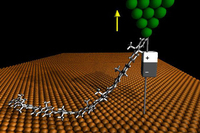Mar 8 2009
For the first time, researchers from CNRS, the Free University of Berlin and Humboldt University (Berlin) have measured the ability of a single, very long molecular wire to carry electric current. Until now, there were only statistical measurements on a collection of wires a few nanometers long.
 Single polymer chains as molecular wires
Single polymer chains as molecular wires
Now, thanks to an ingenious experiment using a scanning tunneling microscope, the researchers have characterized individual polymer chains of known length, up to 20 nanometers long. They confirm what is predicted by theory: the ability to conduct electric current decreases exponentially with the length of the wire. These findings are published in the 27 February 2009 issue of the journal Science.
Tomorrow's electronic circuits will be made up of individual molecules, connected to each other by means of 'molecular electric wires' (themselves consisting of a single, long molecule). But first, researchers need to understand how electric current flows through this type of wire. On the macroscopic scale, the ability to carry current, called conductance, varies linearly as a function of the length and cross-sectional area of the wire. On the scale of a molecule, this rule is no longer valid. Consequently, it is necessary to measure the electric current that flows through a single molecular wire connected to two electrodes and determine how it varies as a function of the length of the wire. Until now, all the experimental studies focused on very short wires (a few nanometers long) or were based exclusively on statistical measurements.
At the Free University of Berlin, in collaboration with CNRS's Center for Materials Elaboration and Structural Studies (Centre d’élaboration de matériaux et d’études structurales) (CEMES) in Toulouse and with Humboldt University (Berlin), researchers carried out an ingenious experiment to measure the conductance of a single molecule with a perfectly defined length. First they placed small molecules on a gold surface, which they bonded chemically to each other by means of a surface polymerisation reaction, which brought about the formation of long molecular chains. They then selected one of the chains by making images of the surface with a scanning tunneling microscope and chemically bonded one end of the chain to the microscope's metal tip, which thus made up one of the two electrodes, while the other end of the polymer remained in position on the gold surface, making up the second electrode.
By moving the tip away from the surface, the researchers gradually lifted up the chain, thus forming a molecular electric wire that became longer as the tip moved away from the surface. The scanning tunneling microscope was used both to measure the length of the selected molecular electric wire (since the resolution of the image is on the atomic scale it can, for example, be used to count the number of monomers2) and to measure the current flowing through it. For the first time, the charge transport through a single polymer chain was measured for different lengths (up to 20 nanometers) between the two electrical contacts.
The results are in agreement with theoretical predictions: the current decreases exponentially with the length of the molecular electric wire. After the success of this innovative experiment, it is now up to chemists to come up with more conductive molecules that can be used to develop molecular wires able to carry current over even greater distances.